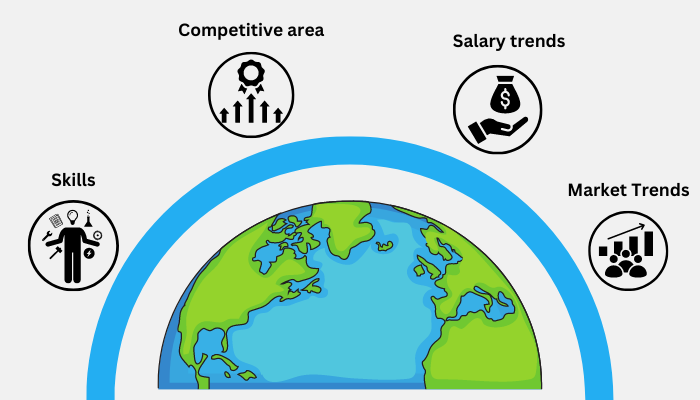We all know that jobs feed data has transformed the recruitment industry. Now, recruiters don’t manually scour through hundreds of resumes to find skilled individuals and let the power of real-time data take its course. Job data analytics have transformed the modern recruitment process and optimized the hiring process for job-seekers. However, one aspect of job data analytics that is not talked about enough is how governments, staffing agencies, Fortune 500 and consulting companies are using job data analytics to unlock market trends.
Yes, you heard it right. The vast and yet targeted job post data isn’t just for talent sourcing but to reveal new market insights that can be used to gain competitive advantage and make informed decisions for the workforce and public welfare.
Here’s how governments all over the world use job listing data:

Central and state governments in different countries use this data to decide job policies. For instance, why are women not applying to a particular job? Or are women being discriminated against in the job market after pregnancy? Data-driven insights can help leaders to take the initiative and bring policy changes accordingly. Not only this, but job data analytics can help the government bring new jobs and understand the impact of the recession on jobs and salary structure. For instance, the Indian government is promoting EVs and green energy resources, has exempted them from taxes, and provided loan assistance for them to grow. This will prompt these companies to expand and create new job opportunities.
Policy-making to reduce regional skill gaps and bring in new legislation
In an emerging economy, not every state in the country is the same regarding skills and education. While it may seem like an employment issue, its overall impact on an economy goes beyond the shortage of skilled employees. It impacts the lifestyle, living standards, and overall well-being of the citizens. An economically weaker community may lack technological and soft skills, resulting in economic stagnation and unemployment. They may even have traditional cultural skills, but to preserve and carry them forward to more and more people, intertwining them with next-generation disruptive technology is important. Analyzing job feed data comes in handy to promote harmonious and equitable economic development. Governments use this data to promote economically weaker yet viable sections. Governments can create a sustainable future for such sections with automation and technology training. It is also important to attract foreign investments and, thus, an integrated aspect of creating a growth-oriented economy.
Based on real-time labor market job data and data-driven insights, governments can tap into the demands and have legislation framed to ensure fair play.
Also read: How can worldwide funding data feed improve your overall investing strategy?
What’s more?

Companies and businesses use job data to dive deeper into labor workforce trends, analyze information, and forecast market trends. This data helps them make a market-oriented strategy and cash in on new opportunities much before their competition, giving them a strategic edge and a chance to stay ahead in the market. Businesses can also make informed decisions and address several workforce challenges using this data.
Jobs data lets businesses address their two pain paints: market and marketing intelligence, decoding the entire market and knowing their customers. Here are a few workplace labor trends companies can unlock using jobs feed data.
Bridging the demand and supply skill gap and upskilling the existing workforce

Workers are looking for jobs. Companies are on the lookout for a workforce. But the workers don’t have the qualifications companies seek in the existing roles. Hence, the vacancies are never filled, and the workers never get hired. This difference in training and education is called the skill gap, which can be identified and assessed with the jobs data.
The challenge of the skills shortage is real and growing. Companies are having a hard time finding the right skill set employees and workers finding a suitable job that suits their skill set. This can impact a business and its profitability adversely, such as:
- Increase in unproductive hours and reduced output
- Employee attrition
- Poor customer experience due to inadequate work skills
- Surplus costs in staff training
- Unmotivated staff
- Poor and shoddy work quality
- Losing the competitive edge and, hence, loss of business and revenue
- No growth in their vertical
Maybe it is industry experience or a lack of soft skills required for a job, but it doesn’t only pertain to the blue-collar workforce alone. This research shows that eight percent of UK employers said that the university graduates they employed lacked life and real-world experience. Six percent of employers admitted that university graduates they have employed don’t have the proper job skills or core competencies required to be on the job.
In other news, the UK government has promised to create two million jobs in the low-carbon, green, and renewable energy sectors by 2030 but cannot because of the green skills gap in the existing workforce. Organizations have no plans and lack government initiatives to upskill and re-skill the workers.
Again, this is just the tip of the iceberg. $11.5 trillion losses in cumulative GDP growth are predicted for 14 G20 countries because of the digital skills gap. Lack of digital skills gap or digital illiteracy impacts innovation, inability to keep up with global demands, delivery delays, and unfulfilled customer experience.
Job data analytics can help a country’s workforce meet global demand and core competencies.
Governments worldwide use employment and jobs data to recognize the jobs trend and figure out the supply and demand gap. For instance, if people are inclined to make a beeline towards hospitality jobs and not towards careers in microbiology, they will nudge and promote the latter by giving subsidies and incentives. They will also prompt the education system to fill the gap and provide education and training programs; logically, companies want to make hay while the sun shines.
Confronting the lack of socio-economic diversity
Job data analytics has helped companies worldwide recognize the persistent class issues and understand the barriers that prevent people from underrepresented sections from accessing a job sector. Is it a lack of core skills, adequate academic infrastructure, or blatant elitism?
A survey reveals that the ethnicity pay gap for marketing has been 8.5 percent, and the gender pay gap has been recorded at 16 percent, a slight improvement from 2022’s 10.2 percent and 16.5 percent, respectively.
The job listing data can map improvement indicators and address socio-economic challenges in a developing economy. Using this data, companies can work towards creating a better and more inclusive workplace and close the wage gap in their industry.
Upskilling the core sector
Automation and generative AI have created a massive disruption in the existing economy. The traditional workforce has suffered setbacks due to the skills gap. In a survey, 29 percent of participant employees accepted that lacking digital skills resulted in pay loss and being sidelined for career progression. Many employees also fear that automation may jeopardize their jobs.
Over 58 percent of workers have felt that employers aren’t helping them with the necessary training to bridge the skill gap. This is when 76 percent of businesses want workers to upgrade their digital skills and admit that a lack of them could hurt the profitability of their business. Skills redundancy is also a common cause of fear among old employees and one of the main reasons behind attrition.
It is evident that lots need to be done, and with jobs feed data, this can be addressed. Businesses can utilize job data to form an organized approach and amplify digital and core technology skills among workers.
Jobs Data Analysis in the Education Segment
Jobs data analysis is harnessed to map the growth indicators of niche sectors and can be used to understand the need for a new education framework.
The education and ed-tech industry has started to analyze job data to address the need for certification in courses in demand and skills that offer high-paying jobs. For instance, AI, cybersecurity, cloud computing, and data analytics skills are highly sought after, and the education industry ensures these demands are met. This ensures timely intervention by launching certification courses and educational programs to provide more skill-based education and make it more accessible so that a more diverse, more inclusive talent pool can access the workstream to create a positive socio-economic impact.
Jobs data for recruitment and talent acquisition
This might be the first and foremost thing that comes to mind about jobs feed data. Businesses and staffing agencies use structured real-time job data to analyze job postings, benchmark industry standards and salary, follow their competition, track the evolving skill set for a particular niche, and find the right candidate. The AI and automation have caused a ripple effect in workforce planning. Using job listing data, companies and recruitment agencies can get an up-to-date, concise, and reliable data stream listing all jobs in one place to track down a talent pool that matches their requirement.
Listening in on to the labor market trends and acing them
With job data analytics, businesses can adopt a forward-thinking approach and forecast the skill set that they can bank upon in the future. They can also track a talent pool that has the skills they might need in the future and facilitate faster hiring. Social listening is also one of the perks of harnessing labor market insights at a workplace. They can understand what skills are in demand and what their employees want. 2024 workplaces are all about inclusivity, work-life balance, and pay equity. Businesses and companies can achieve that and much more with jobs data feed. If they can offer perks beyond mere gift cards and create a real difference in employees’ lives, employees, too, try to be more productive and skills-oriented.
The jobs data feed can also be used as an indicator of recession in the market. If the companies are downsizing or going on a hiring spree, they can showcase the market trend.
Jobs Posting Data Feed to gain a competitive edge in your niche market

If a competitor hires for a new product or service, it shows on the job feed. This is when you know that the other company is expanding, and maybe it is time for you to do so. You can use this data to elevate your business strategy and expand your business. Similarly, the frequency of competitor job data can shed light on the internal ecosystem of that company. If the attrition rate is high, it can showcase inner turmoil, unhappy employees, or possible downsizing. The job data can also help in mitigating risks owing to market volatility.
Also read: Future of B2B Marketing: Insights and Statistics
Get leads in line
Location-based jobs data can help businesses identify opportunities and understand demand. They can amplify their sales effort and address the growing demand in time, cashing on opportunities when they arise.
Also read: Digital has changed the role of sales enablement
How is BizProspex your one-stop platform to analyze the Jobs Market?

Structured real-time jobs data is the need of the hour for both governance and business. Choosing the right job listing data provider is crucial for businesses and staffing companies. BizProspex sources job data across the world, ensuring it is extensive and varied. The data is ready-to-use, automatically aggregated, deduplicated, categorized, and available through a data feed. The data coverage isn’t a one-size-fits-all. BizProspex believes that every business is unique and has unique challenges to overcome. Hence, the datasets are tailor-made and unique to your business’s needs.
BizProspex offers a cost-effective model for job data analytics and dedicated business support. It is easy to scale, and you can always switch to the model suitable for your business.
Contact us now for a demo call or download a free customized sample jobs feed data for your company.
